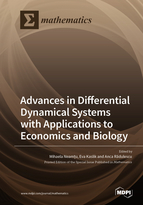Advances in Differential Dynamical Systems with Applications to Economics and Biology
A special issue of Mathematics (ISSN 2227-7390). This special issue belongs to the section "Dynamical Systems".
Deadline for manuscript submissions: closed (31 March 2022) | Viewed by 25602
Special Issue Editors
2. Institute for Advanced Environmental Research, West University of Timişoara, 300223 Timişoara, Romania
Interests: nonlinear dynamics; economic modeling; differential equations; stability analysis; biomathematics; numerical simulation; mathematical modeling
Special Issues, Collections and Topics in MDPI journals
2. Institute for Advanced Environmental Research, West University of Timişoara, 300223 Timişoara, Romania
Interests: dynamical systems; fractional-order differential equation; delay differential equations; mathematical modeling
Special Issues, Collections and Topics in MDPI journals
Interests: dynamical systems; mathematical biology; computational neuroscience
Special Issues, Collections and Topics in MDPI journals
Special Issue Information
Dear Colleagues,
Nowadays, in order to study economic and biological processes, mathematical modeling is a very useful tool. In economics and biology, a delay between cause and effect is very often taken into consideration. Sometimes, it is more practical to add a distributed time delay because it illustrates the situation where delays arise in certain ranges of values for certain related probability distributions, taking into account the variables’ entire historical behavior. Moreover, fractional derivatives instead of integer order derivatives may reflect the memory and the inherited properties of different systems. In terms of realistic conditions, stochastic perturbation framed by a stochastic differential delay system is used to explain the ambiguity about the context in which the system operates.
This Special Issue focuses on the dynamical analysis of mathematical models arising from economy and biology and innovative developments of mathematical techniques for their applications. Submissions that involve interdisciplinary collaborations are welcome, as are recent advances in both discrete and continuous techniques and significant applications. Numerical simulations can be used to emphasize the theoretical findings. Finally, an economic or biological interpretation of the obtained results is desired.
Prof. Dr. Mihaela Neamțu
Dr. Eva Kaslik
Dr. Anca Rădulescu
Guest Editors
Manuscript Submission Information
Manuscripts should be submitted online at www.mdpi.com by registering and logging in to this website. Once you are registered, click here to go to the submission form. Manuscripts can be submitted until the deadline. All submissions that pass pre-check are peer-reviewed. Accepted papers will be published continuously in the journal (as soon as accepted) and will be listed together on the special issue website. Research articles, review articles as well as short communications are invited. For planned papers, a title and short abstract (about 100 words) can be sent to the Editorial Office for announcement on this website.
Submitted manuscripts should not have been published previously, nor be under consideration for publication elsewhere (except conference proceedings papers). All manuscripts are thoroughly refereed through a single-blind peer-review process. A guide for authors and other relevant information for submission of manuscripts is available on the Instructions for Authors page. Mathematics is an international peer-reviewed open access semimonthly journal published by MDPI.
Please visit the Instructions for Authors page before submitting a manuscript. The Article Processing Charge (APC) for publication in this open access journal is 2600 CHF (Swiss Francs). Submitted papers should be well formatted and use good English. Authors may use MDPI's English editing service prior to publication or during author revisions.
Keywords
- dynamical systems
- time delay
- stability
- bifurcation analysis in economic and biological systems
- chaotic behavior
- fractional order systems
- numerical methods
- numerical simulations







